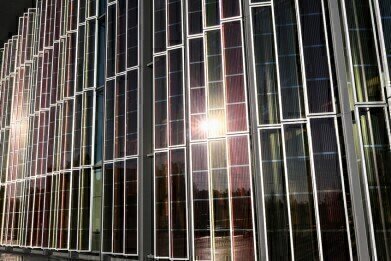-
 An example of dye-sensitised solar cell modules used at the Swiss Tech Convention Center in Lausanne, Switzerland. (Credit: EPFL/Chris Blaser)
An example of dye-sensitised solar cell modules used at the Swiss Tech Convention Center in Lausanne, Switzerland. (Credit: EPFL/Chris Blaser)
News
Supercomputing Speeds Hunt for Light-Harvesting Chemicals
May 08 2019
In an international project to make solar panels more effective at creating electricity and in ways which are environmentally friendly, an international team of scientists led by the UK, searching for new, organic light-harvesting chemicals, harnessed the power of supercomputing to sift through thousands of scientific journals, for data collection on nearly 10,000 organic dyes.
Researchers at STFC’s ISIS Neutron and Muon Source and the Research Complex then developed an algorithm that paired dyes, which together could absorb all light wavelengths. From this shortened list the search was restricted to just organic molecules, which are able to absorb a smaller range of wavelengths than metal-containing dyes that are traditionally used.
Project lead Professor Jacqueline Cole, oint appointment between the ISIS Neutron and Muon Source and the University of Cambridge, said: “We felt that is was important to focus on organic molecules, since we believe in an environmentally friendly approach to device technology; eco-technologies are also strategically relevant looking ahead, as more and more environmental government regulations become enforced to cope with Earth’s limited material resources and averting pollution of the natural environment.”
An algorithm was then used to predict which of the molecules would be the best at absorbing electrons from light to convert into electricity. After narrowing the field from almost 3,000 to 30, the group were then able to find the five most promising candidates.
As each of these five dyes had already been made by teams around the world for other reasons, the research group appealed for dye samples to study. When used in a photovoltaic device, these were found to be as effective at converting light into electricity as the industrial standard, metal-containing dye.
The team used the Materials Characterisation Laboratory at STFC’s ISIS Neutron and Muon Source to observe how the working electrodes of the solar cells operate at the molecular scale. These working electrodes were part-fabricated at the Research Complex at Harwell.
Professor Cole added: “The finding that our results can perform as well as the traditional organometallic dyes in this type of solar cell demonstrates that it is worth giving more serious consideration to the use of organic dyes in solar-cell manufacture. More tests naturally need to be undertaken, to assess their practical manufacturing needs at industrial scale and viability under real-world commercial conditions.”
Digital Edition
Lab Asia Dec 2025
December 2025
Chromatography Articles- Cutting-edge sample preparation tools help laboratories to stay ahead of the curveMass Spectrometry & Spectroscopy Articles- Unlocking the complexity of metabolomics: Pushi...
View all digital editions
Events
Jan 21 2026 Tokyo, Japan
Jan 28 2026 Tokyo, Japan
Jan 29 2026 New Delhi, India
Feb 07 2026 Boston, MA, USA
Asia Pharma Expo/Asia Lab Expo
Feb 12 2026 Dhaka, Bangladesh


















